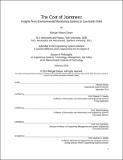| dc.contributor.advisor | Edward F. Crawley. | en_US |
| dc.contributor.author | Dwyer, Morgan Maeve | en_US |
| dc.contributor.other | Massachusetts Institute of Technology. Technology, Management, and Policy Program. | en_US |
| dc.date.accessioned | 2015-06-10T19:09:32Z | |
| dc.date.available | 2015-06-10T19:09:32Z | |
| dc.date.copyright | 2014 | en_US |
| dc.date.issued | 2015 | en_US |
| dc.identifier.uri | http://hdl.handle.net/1721.1/97323 | |
| dc.description | Thesis: Ph. D. in Technology, Management and Policy, Massachusetts Institute of Technology, Engineering Systems Division, Technology, Management, and Policy Program, February 2015. | en_US |
| dc.description | Page 351 blank. Cataloged from PDF version of thesis. | en_US |
| dc.description | Includes bibliographical references (pages 337-350). | en_US |
| dc.description.abstract | The term jointness refers to activities or operations that are executed collaboratively by more than one government agency or military department. While joint operations have become increasingly common and successful, the government continues to struggle with joint system acquisition: in fact, although a common motivation for joint acquisition is cost savings, recent studies suggest that joint programs experience larger cost growth than non-joint programs and that it may be more cost effective for agencies to acquire systems independently rather than jointly. This thesis explains why joint programs often experience large cost growth and how jointness itself may induce it. To understand the cost of jointness, this thesis proposes and demonstrates a new approach for studying large, complex acquisition programs whereby the evolution of a program's organizational and technical architectures is quantified and observed using a design structure matrix (DSM)-based tool. Using this approach, one is able to gain an in-depth understanding of the underlying mechanisms that drive a program's costs, as well as global perspective on cost growth throughout a program's lifecycle. The utility of this approach is demonstrated by applying it to study the cost impacts of jointness on three programs that developed environmental monitoring systems for low Earth orbit. The acquisition community's current understanding of joint programs suggests that jointness induces cost growth by increasing a program's organizational and technical complexity. However, using the DSM-based tool, this thesis demonstrates that complexity is a dynamic property of an acquisition program that is driven by government agencies' institutional interests and the actions that they motivate. Specifically, the thesis presents a more nuanced understanding of jointness, complexity, and cost growth by arguing that government agencies' institutional interest in retaining or regaining autonomy motivates actions that alter the agencies' relationships with one another, with the joint organization, and with the system under development. When agencies take action to retain or to regain autonomy, they increase the complexity of the joint organization or the joint system and the program's costs grow as result. Finally, the thesis discusses the implications of the proposed Agency Action Model both generally and specifically in the context of environmental monitoring programs. Aided by a trade space analysis tool that was developed to explore a broad set of concepts for future environmental monitoring systems, the thesis demonstrates how government leaders should approach the problem of joint program formulation and in doing so, generates a set a policy recommendations for future partnerships between the agencies that have historically collected environmental data from low Earth orbit. | en_US |
| dc.description.statementofresponsibility | by Morgan Maeve Dwyer. | en_US |
| dc.format.extent | 351pages | en_US |
| dc.language.iso | eng | en_US |
| dc.publisher | Massachusetts Institute of Technology | en_US |
| dc.rights | M.I.T. theses are protected by copyright. They may be viewed from this source for any purpose, but reproduction or distribution in any format is prohibited without written permission. See provided URL for inquiries about permission. | en_US |
| dc.rights.uri | http://dspace.mit.edu/handle/1721.1/7582 | en_US |
| dc.subject | Engineering Systems Division. | en_US |
| dc.subject | Technology, Management, and Policy Program. | en_US |
| dc.title | The cost of Jointness : insights from environmental monitoring systems in low Earth orbit | en_US |
| dc.title.alternative | Insights from environmental monitoring systems in low earth orbit | en_US |
| dc.type | Thesis | en_US |
| dc.description.degree | Ph. D. in Technology, Management and Policy | en_US |
| dc.contributor.department | Massachusetts Institute of Technology. Engineering Systems Division | |
| dc.contributor.department | Technology and Policy Program | |
| dc.identifier.oclc | 910320063 | en_US |
